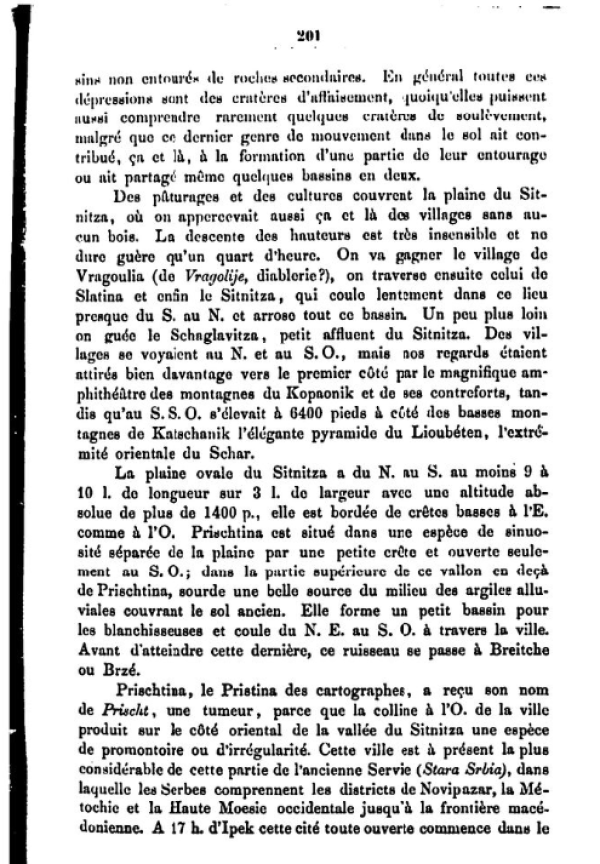1838, Ami Boué

Recueil d’itinéraires dans la Turquie d’Europe. détails géographiques, topographiques et statistiques sur cet empire
PRISTINA
Prishtina, called Pristina by the cartographers, got its name from prischt 'tumor, boil' because the hill to the west of the city takes an irregular shape from a spur that comes from the eastern side of the Sitnitca valley. This city is currently the largest in this part of Old Serbia (Stara Srbia), in which the Serbs also include the district of Novipazar, Metohija [Metohija] and western Upper Moesia up to the Macedonian border. At a distance of about 17 hours from Peja, this completely open city begins in a small valley that stretches eastward in the form of an amphitheater to the last slopes of a low ridge at a slope that seems rather unpleasant. If the hills to the west and north are covered with vineyards, those to the east are entirely populated by dry pastures, while the lower part serves as the city's cemetery. Between the latter [cemetery] and the first houses are the remains of a small earth ditch and some low parapets dating from the time of the riots in 1806 when gangs of thieves terrorized the village. To the northwest is another cemetery. Most of the roads are unpaved and uneven. They are cleaned by the rain and by the small stream mentioned above. Butchers' shops on the main street offer huge hunks of meat and guts dripping with blood for a space of 20 paces, and brown dogs fight among themselves for these scraps in a gruesome scene.
The only notable buildings in Pristina are the clock tower and twelve mosques, two of which are tall and round in shape, painted in arabesques or long verses from the Koran. A small mosque was built by Jashar Pasha, who held that post in 1837 and 1838. The bazaar is clapboarded and has a cafe where the three main streets meet. The pasha's mansion is a large building built partly of wood. There are two wings and the upper floor with a large square courtyard, spacious corridors and wooden stairs, according to the custom. One wing of the guest house is painted in arabesques. It is connected by road to the harem, which is also a rather large house, mostly made of wood, with closed windows. The Pasha's divan has no glass windows. The windows are closed by simply folding down the wooden shutters. There were also swallows' nests on the ceiling.
Pristina seemed to me to have a population of about 7,000 to 9,000 souls, among whom are a good number of Orthodox Serbs together with Albanians and semi-Muslim Serbs. Mr. Jurishic assessed 3,000 houses, a third of which were Serbian. This is the capital of the small paschal which includes not only the basin of Sitnica up to Vushtrri, but also part of the surrounding mountains, the valley of Drenica and the upper reaches of the valley of Lepenci. The only miserable settlements that can be found here are Vushtrri and Kratova which also have aja. All other settlements, with the exception of the city of Pristina, are such villages that rarely have even an aga. The population consists of Serbs and some Bulgarians and Albanians, including a certain number of Serbs who have become half-Albanian and Muslim for political reasons or by marriage. Albanians live mainly in the south and southwest of the pashalik and Serbs on the opposite sides. The total population is not more than 40,000 to 50,000 souls and not less than 30,000.
Boué, Ami (1854). Recueil d'itinéraires dans la Turkey d'Europe. détails geographiques, topographiques et statistiques sur cet empire. Vienna: Braumüller, p. 201–203. Printed material. (Translation: Y. R.)